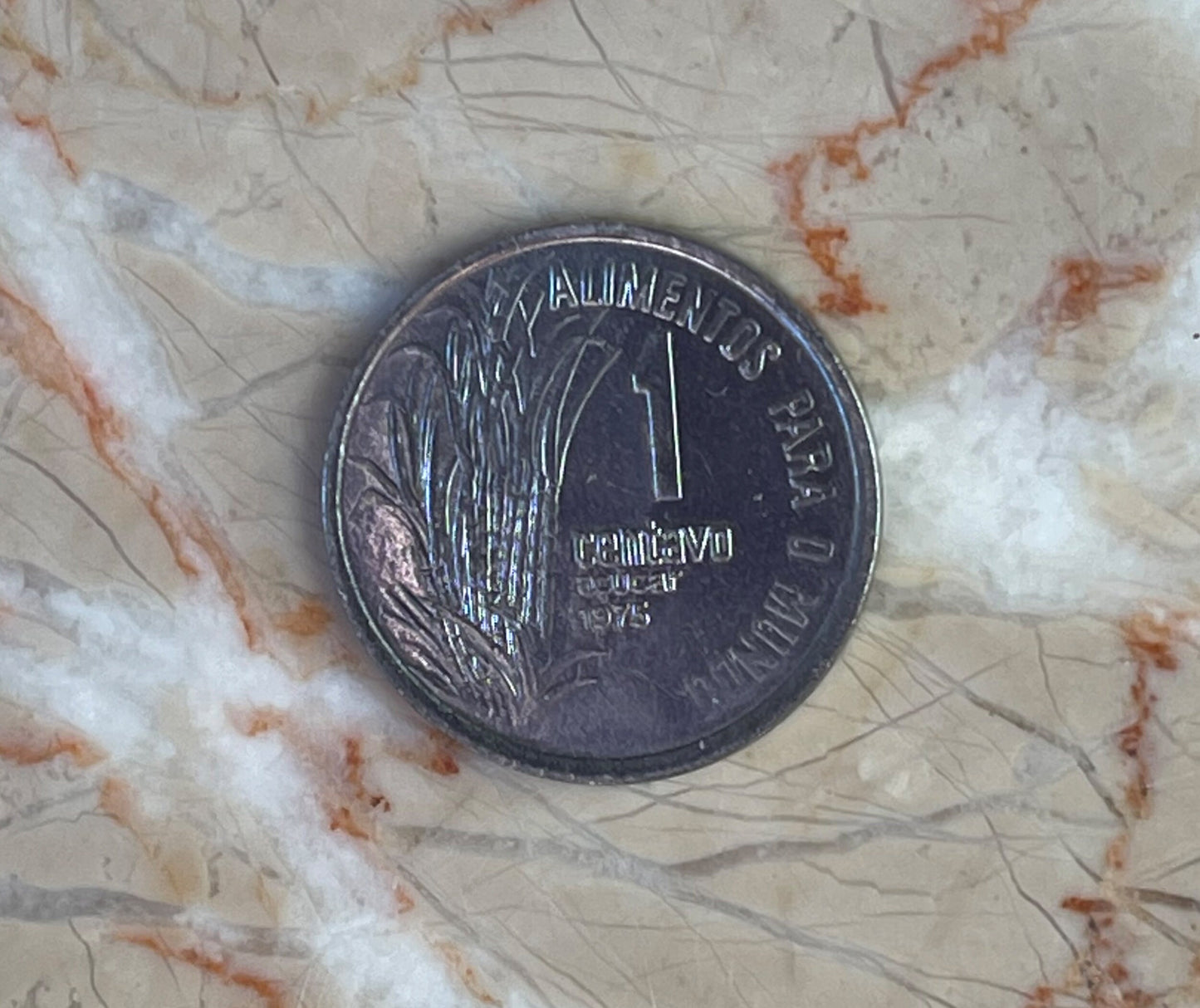elemintalshop
Sugar Cane & "Food for the World" 1 Centavo Brazil Authentic Coin Money for Jewelry and Craft Making
Sugar Cane & "Food for the World" 1 Centavo Brazil Authentic Coin Money for Jewelry and Craft Making
Couldn't load pickup availability
Sugar Cane Brazil Authentic Coin Charm 1 Centavo for Jewelry and Craft Making
Commemorative issue
Series: FAO
Obverse
Effigy of Republic and the country name to the left
Reverse
Sugar Cane, denomination, and date to the right
Lettering: ALIMENTOS PARA O MUNDO
1 centavo
açúcar
Translation: Food for the World
1 Centavo
Sugar
Features
Issuer Brazil
Period Federative Republic of Brazil (1967-date)
Type Circulating commemorative coin
Years 1975-1978
Value 1 Centavo (0.01 BRB)
Currency Cruzeiro novo (1967-1986)
Composition Stainless steel
Weight 1.77 g
Diameter 17 mm
Thickness 1.15 mm
Shape Round
Technique Milled
Orientation Coin alignment ↑↓
Demonetized 31 December 1980
Number N# 5383
References KM# 585, Schön# 91
Wikipedia:
Sugarcane is the world's largest crop by production quantity, with 1.8 billion tonnes produced in 2017, with Brazil accounting for 40% of the world total.
Sugarcane was an ancient crop of the Austronesian and Papuan people. It was introduced to Polynesia, Island Melanesia, and Madagascar in prehistoric times via Austronesian sailors. It was also introduced to southern China and India by Austronesian traders at around 1200 to 1000 BC. The Persians and Greeks encountered the famous "reeds that produce honey without bees" in India between the 6th and 4th centuries BC. They adopted and then spread sugarcane agriculture. Merchants began to trade in sugar, which was considered a luxurious and expensive spice, from India. In the 18th century AD, sugarcane plantations began in Caribbean, South American, Indian Ocean and Pacific island nations and the need for laborers became a major driver of large migrations of people, some voluntarily accepting indentured servitude and others forcibly exported as slaves. (Wikipedia)
**********
Soon after Columbus returned from his first voyage to the new world it became apparent to old world investors and the Spanish crown that the new territories could not be exploited as had been hoped. Indeed, Magellan’s circumnavigation of 1519-1522 proved that the territories visited by Columbus weren’t even parts of Asia, but a continent that could offer little in the way of spices and manufactured goods such as were exported from east Asia. However, the Europeans quickly realized that the new world possessed potential of a different sort: the production of sugar cane. Consequently, the plantation system and the sugar refining industry, rather than the harvesting of spices and silk production, were destined to shape the economy and society of Brazil and the West Indies.
The European discovery and colonization of Madeira and the Canary Islands would prove fateful precedents for the new world, because the plantation system and colonial governments instituted on these islands became models for the great sugar plantations in the new world. Since sugar cane had been introduced to Madeira and the Canaries after their colonization during the last half of the fifteenth century, the techniques of sugar production, exploitation of labor, and economic organization developed on these islands were easily exported to the new world. Ultimately, the adoption of these production techniques and the system of colonial government from the Atlantic islands, with the institution of slavery, made sugar production the most profitable cultivation in either the Americas or Europe.
The earliest large-scale production of sugar was established in Brazil, along the Atlantic coasts surrounding Bahia and Pernambuco. Although sugar cane was reputedly first planted in Brazil in 1516, it was apparently done as much for strategic as economic reasons, because the European powers were struggling for legal and economic claims to territory in the Americas. For the next four decades, trade with Brazil centered around the harvest of dyewood, since the demand and prices for sugar had slumped in Europe. But, by the sixteenth century, both demand and prices had risen because refined sugar was replacing honey in most recipes and was increasingly used as a sweetener in jams, jellies and other popular food products. The first commercial production of sugar in the new world was undertaken in 1550, when the Portuguese Donatarios built mills near Pernambuco and São Vicente along the Atlantic coast of Brazil. This early production was derived principally from techniques developed in Madeira, based upon a system resembling sharecropping, where the owner, or senhor de engenho, leased his land to a number of smaller planters in return for a portion of the sugar produced.
https://www.lib.umn.edu/bell/tradeproducts/sugar
Front of coin:
The effigy is a representation of a young woman wearing a crown of bay leaves in Roman style and a phrygian cap. It is present in allegoric paintings and sculptures displayed in government buildings throughout Brazil, and engraved on Brazilian real coins and banknotes. It was first used as a pro-Republican icon in the 19th century, inspired by France's Marianne. After the proclamation of the Republic in 1889, it became an important symbol of the newly formed Republic. (Wikipedia)
Share





